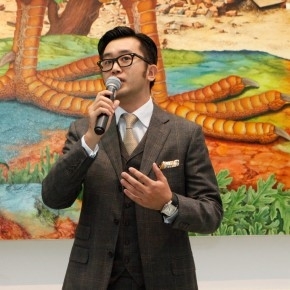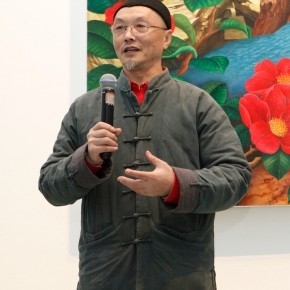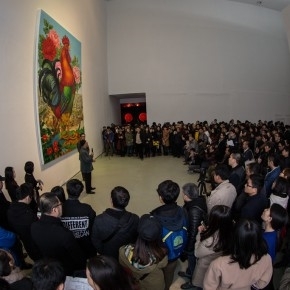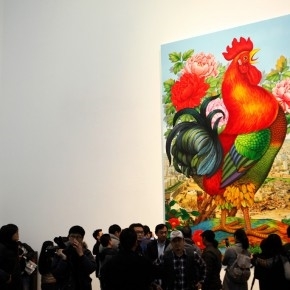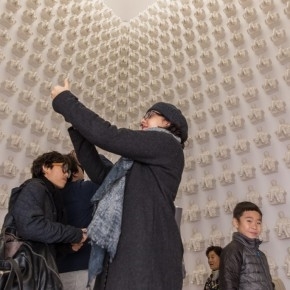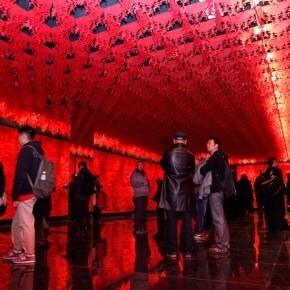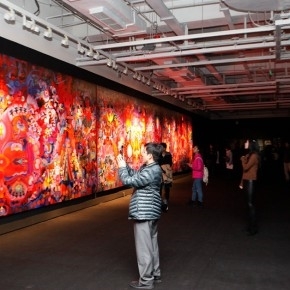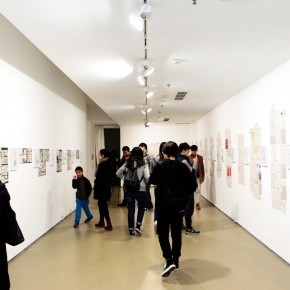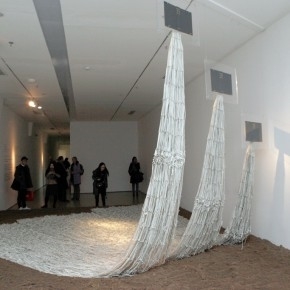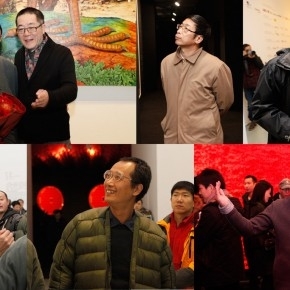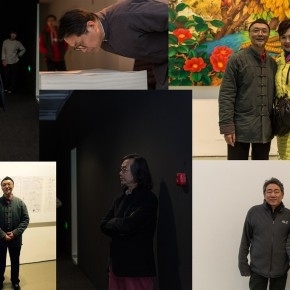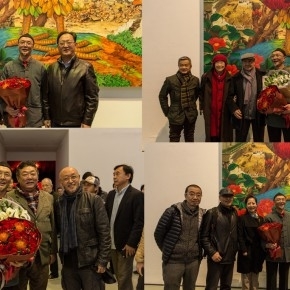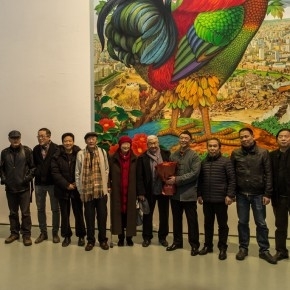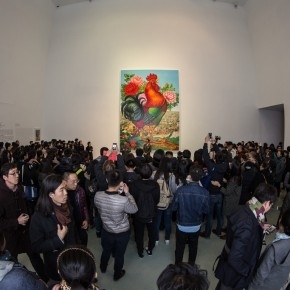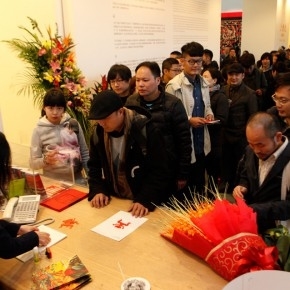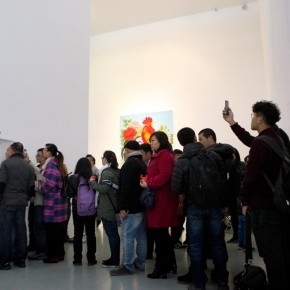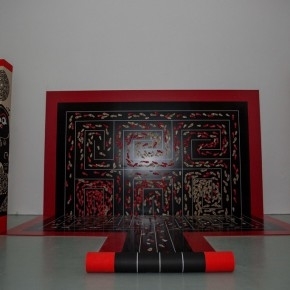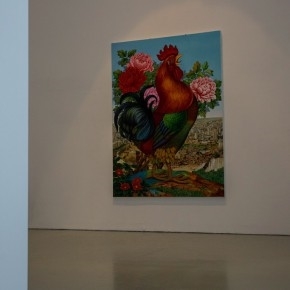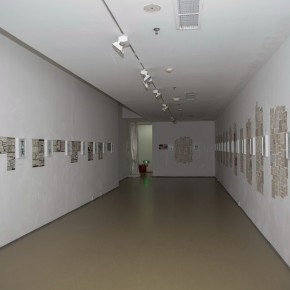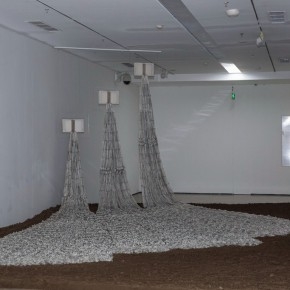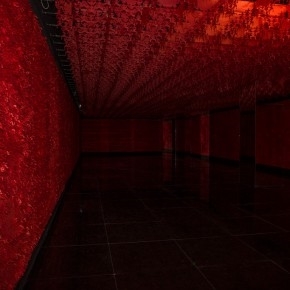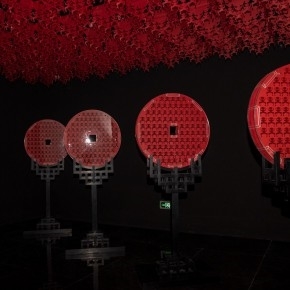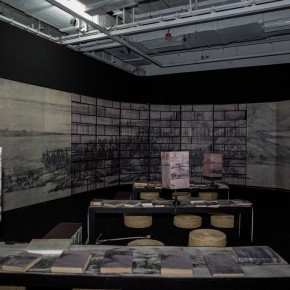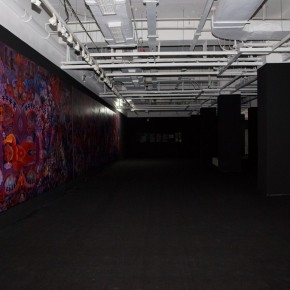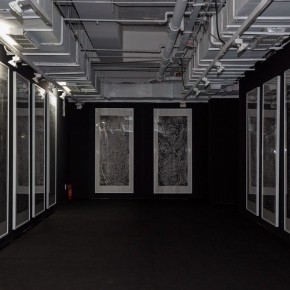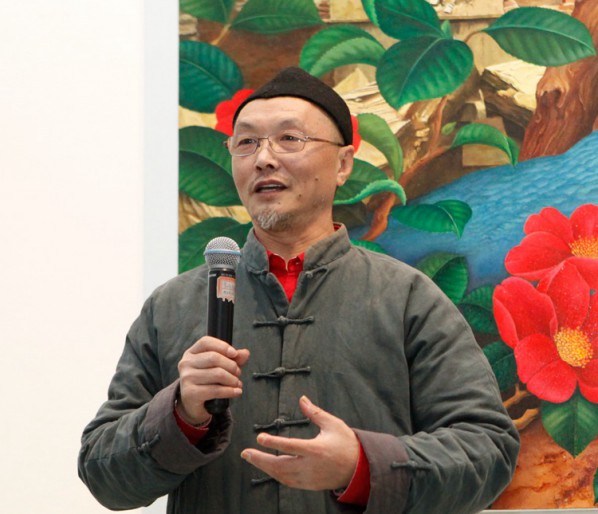
At 16:00 on November 8, 2015, “Last Century: Lv Shengzhong Solo Exhibition” was inaugurated at the Gallery No. 1 of Today Art Museum. Prof. Yang Xianrang and Prof. Feng Zhen who have instructed Lv Shengzhong, leaders and professors from various schools of CAFA come to attend the opening ceremony and conveyed their congratulations on his achievements. Honored guests included: Vice President of CAFA Su Xinping, Vice Secretary of the Party Committee of CAFA Sun Hongpei and Wang Shaojun, Curator of CAFA Art Museum Wang Huangsheng, Director of the Office of Academic Affairs Wang Xiaolin, Publicity Manager Qin Jianping, Prof. Chen Wenji, Prof. Ma Lu, Prof. Sui Jianguo, Prof. Xu Bing, Prof. Tan Ping, Prof. Yin Shuangxi, Prof. Qiu Zhijie and so on. Besides, Lv’s students and other art lovers come to join the ceremony as well.
Prof. Lv shared his feelings and experiences at the press conference, he believed that this exhibition was quite different from those held in the Europe and the United States of America. After all, it was presented on his motherland and the space for him to express himself was more sufficient. He had worked hard on planning how to effectively use the Gallery No. 1 of Today Art Museum before it’s presented to the public. He thought the exhibition did not belong to himself but it was a way that an artist found his independent personality for he has experienced the encouragements and supports from the art media group, his colleagues, friends and students. He believed that the exhibition was fixed in the style from the last century, that it had no curators, no galleries and no dramatic reportage, instead, it’s a steady start.
The opening ceremony of this exhibition was chaired by Yan Zi, Deputy Director of Today Art Museum. She briefly introduced the exhibition from the very beginning, that it featured 11 pieces of work by Lv Shengzhong, and they were exhibited at the 2nd, 3rd and 4th floors according to the four chapters of the exhibition. Gao Peng, Director of Today Art Museum mentioned in his speech that, this was the largest important exhibition in scale but with the simplest press conference and opening. All of the works on this show span over thirty years of the artist’s practice, in a comprehensive way they presented his art as well as his academic thoughts.
It’s been nearly thirty years since his first exhibition of paper-cutting was held at the National Art Museum of China and it’s been ten years since his latest exhibition held in New York. Artist Lv Shengzhong said that, since 2000, basically speaking, he did not seriously work on his own art, instead, he has been devoted himself to the art education of “Experimental Art” and he believed that was more significant and meaningful than his solo exhibitions with several pieces of work. He hoped, he would go ahead on the road of education and creations with steady and slow paces, like a bearer on Mountain Taishan.
The exhibition will remain on view till 1 January, 2016. The seminars related to this exhibition will be held on 5 December and 6 December at Today Art Museum.
Text by Ye Yuanfeng, translated and edited by Sue/CAFA ART INFO, Photo Today Art Museum
Artist’s Preface: Why “Last Century”?
By Lv Shengzhong
I. It was the 70s of the last century when I reluctantly boarded the arc of art. Soon I discovered the joy of it and devoted all my energy and passion to it. Art however, which has now become a profession, is no longer the Garden of Eden where the human spirit and soul may rest. This led me to attempt to jump ship twice and I was later called a “present day ancient” by friends. At last I found that there is no escape because there is no “Peach Blossom Spring” in the contemporary world.
I am obviously more “rural” compared to other contemporary artists. A fellow artist once analyzed the difference between himself and me, saying that I was more like a farmer. Of course I am. The ancestors of most Chinese people are farmers who lived off the land, therefore the millennia old agricultural society would always show through attempts to transfigure as “modern”. My father’s generation still remain in the rural countryside and although I no longer work in farming, the traces of the soil were definitely more evident in me. Both ancient people and farmers lead me to contemplate, on being a misfit in the contemporary world, being obtuse by nature or having a self-supporting point of view. I am not stupid. I am but looking to elevate myself, body and soul, I remain as an hermit in the city.
II. My love for folk art started around 1980, when I first discovered the essence of Chinese culture in all its richness and vastness within the austere forms of rural customs. I decided it was worthy for me to devote myself to learn from this, in order to nurture my fragmented sense of culture. Doing this work at the time was much like being on the bench during a game. First and foremost, “Rural” is regarded as the opposite of “Western”, which was at the time widely held as the standard of beauty. Meanwhile the cultural establishment did not see the aesthetic tradition of common people as an integral part of Chinese culture. The cultural elite nouveau even wanted to abolish Confucius, let alone the most rural clay sculptures and papercutting.
Until now, (Chinese) people have been desperately rushing towards the goal of modernity, unwilling to spare their energy to mend their cultural context. Although many have realized the value of tradition, greed has often turned the flag of culture into billboards of commerce. Therefore I would rather wait on the bench of yesteryear, than have the heritage in my hands tainted by the smog of today.
III. Since 2000, I have hardly worked seriously as an artist and have devoted myself to the educational work of “experimental art” at the Academy, which was far more meaningful and challenging than creating a few works or holding a few exhibitions. I am proud of the achievements of my students meanwhile the academic works of starting a new faculty also helped me reorganize my understanding of art and revitalized my thoughts. My only regret is that I hardly had the time to exert the impulse to create what remains within me. Therefore I kept the spark of inspiration under the ashes, only waiting for it to ignite when the time is right.
Now that my solo exhibition at the Today Art Museum is in order, I suddenly realized that I have become a stranger to the current art scene and even begun to feel anxious about the socializing aspect at openings. I have thus started to reminisce on the days before 2000. There were not as many galleries, museums or opening galas and parties, no luxurious art studios, surging art markets nor speculative art brokers. I felt like in order to reemerge today I had to start departing from that time, the thought of this made me burst into laughter.
IV. At the end of the previous century, Nietzsche proclaimed the death of God through Also Sprach Zarathustra, in which he proposed the “Revaluation of all values”. This is based on the moral deterioration at the time and the subsequent transfiguration of men, which called for a new Übermensch to guide the “Eternal Recurrence”. However, while God has indeed stopped acting, there is still no sight of the Übermensch. The world has entered a frenzy people have unleashed their desires and the East was no exception. The restraint and confidence that was once commonly found among the Chinese has been lost, thus the people that have humiliated their own nation were held as heroes. Under the flag of breaking up with the 5000 year old tradition, they uprooted their culture, forgot about their ancestors and went westbound.
For China, last century marked the start of social transformation. It was the birthplace of the so-called new culture and the beginning of modernization. Issues that we have attempted to solve in the past hundred years became issues of the last century. Great hardships have been endured and great sacrifices made during this period and the results today are not what we yearned for. It could be said that the new century in its real sense has not yet begun. If we feel dazed by the illusion of arriving at “Modernity”, it is not due to jet-lag of our biological clock but a dysfunction of the vegetative nerves. Where has the time gone? In my opinion, rather than dying after indulging in the nightmare that is called modernity, it is better to take a step back.
October 10th, 2015 at Turning Point, Beijing
About the artist
1952 Born in Dayuji Village, Dongping, Shandong, China
1978 Graduated from Department of Fine Arts, Shandong Normal University, Shandong
1987 Graduated from Central Academy of Fine Arts (MFA), Beijing
Solo Exhibitions
2015 Last Century, Today Art Museum, Beijing, China;
2010 Lu Shengzhong: A Decade, Chambers Fine Art, New York, USA;
2009 Shang Hai: Auspice From Above, Himalayas Art Museum,Shanghai;
2007 Square Earth, Round Heaven, Chambers Fine Art, New York, USA;
Zhaxidele: Auspice From Above, Tibet, China;
2005 The New Emerging From the Old, University Art Museum, University of Albany, New York, USA;
2004 The Book of Humanity, Chambers Fine Art, New York, USA;
2003 Auspice From Above, Eslite Gallery, Taipei, Taiwan;
2002 A la nuit tombée-Lu Shengzhong, Grenoble, France;
2001 Lu Shengzhong: World! Fukuoka Art Museum, Fukuoka, Japan;
2000 First Encounter, Chambers Fine Art, New York, USA;
Good-bye Sorceress, Chidao Countryside, Xunyi, Shanxi, China;
1996 Calling the Soul, Fukuoka Art Museum, Fukuoka, Japan;
1995 ORT-+, Wuppertal, Germany;
1994 Soul Stele, Adelaide, Australia;
Soul Market, Beck Forum, Munich, Germany Emergency Center, St. Petersburg, Russia;
1992 Red Train, Emden, Berlin, Wiesbaden, Hamburg, Germany;
1991 Calling the Soul: Paper-cut Exhibition, Museum of Contemporary Art, Beijing, China;
1990-92 Calling the Soul, Beijing, Hebei, Shanxi, Hunan, Guangxi, Liaoning, China;
1990 Calling the Soul, CAFA, Beijing, China;
1989 Life: Ephemeral and Eternal, Taipei, Taiwan;
1988 Lu Shengzhong: Papercut Art Show, National Art Gallery of China, Beijing (NAGC), China;
1987 Graduation Exhibition, CAFA Gallery, Beijing, China;
Selected Group Exhibitions
2010 ZAO XING, CAFA Art Museum, Beijing, China;
2009 COLLISION-Experimental Cases of Contemporary Chinese Art, CAFA Art Museum, Beijing, China;
2008 CHINESE GARDENS FOR LIVING, Schloss Pillnitz, Dresden, Germany;
2007 Perfect Imbalance, Exploring Chinese Aesthetics, The Peabody Essex Museum, Massachusetts, USA;
Out of the Ordinary: Spectacular Craft, Victoria & Albert Museum, London, United Kingdom;
'85 New Wave- The Birth of Chinese Contemporary Art, Ullens Center for Contemporary Art, Beijing, China;
Net: Reimagining Space, Time and Culture, Chambers Fine Art, Beijing, China;
The Quiet Gesture: Recent Chinese Art, The Newark Museum, New Jersey, USA;
2006 Shu: Reinventing Books in Contemporary Chinese Art, China Institute, New York, USA;
2005 The Wall: Reshaping Contemporary Chinese Art, Alrbight-Knox Galleries, University at Buffalo Art Galleries, New York, USA and Millennium Art Museum, Beijing, China;
2004 Artisti cinesi fra tradizione e presente, Marsilio Art Museum, Italy;
Universal Figure—A. R. Penck Lu Shengzhong, White Space Gallery, Beijing, China;
2003 Guangzhou Triennial, Guangzhou Museum of Fine Art, Guangzhou, China;
Blue Sky Exposure, Yizhuang, Beijing, China Synthi-Scapes: Chinese Pavilion of the 50th Venice Biennale, (it’s canceled due to SARS), later shown in Guangzhou Museum of Fine Art, Guangzhou, China; Openness, China Art Museum, Beijing, China Left Hand, Right Hand, 798 Art Space, Beijing, China;
2002 After All, de waan, Venray Asylum, Holland;
2001 Beijing-Dachauer, Dachauer Schloss, Germany;
Clues to the Future, Red Gate Gallery, Beijing, China;
2000 Gate of the Century: 1979-1999 Chinese Art Invitational Exhibition, Contemporary Art Museum, Chengdu, China;
1998 Notes Across Asia, Berlin, Germany;
Recalling tradition, German Embassy, Beijing, China;
1996 Arcos da Lapa, Rio De Janeiro, Brazil;
Origin and Myths of Fire, Museum of Modern Art, Saitama, Japan;
1995 Kwangju Biennale: Beyond the Border, Kwangju, Korea;
The 4th Asian Art Show: Realism as An Attitude, Setagaya Art Museum, Tokyo, Japan;
1994 Asian Art Show, Fukuoka Art Museum, Fukuoka, Japan;
1992 Post-Mao Product: New Art From China, Australia;
1989 China Avant-Garde, National Art Museum, Beijing, China;
Exhibition Curation
2012 Vanguard Class, CAFA Art Museum, Beijing, China;
Jiang Qi, Chambers Fine Art, Beijing, China;
2011 Harmonious Differences-Second Experimental Art Exhibition, CAFA Art Museum, Beijing, China;



